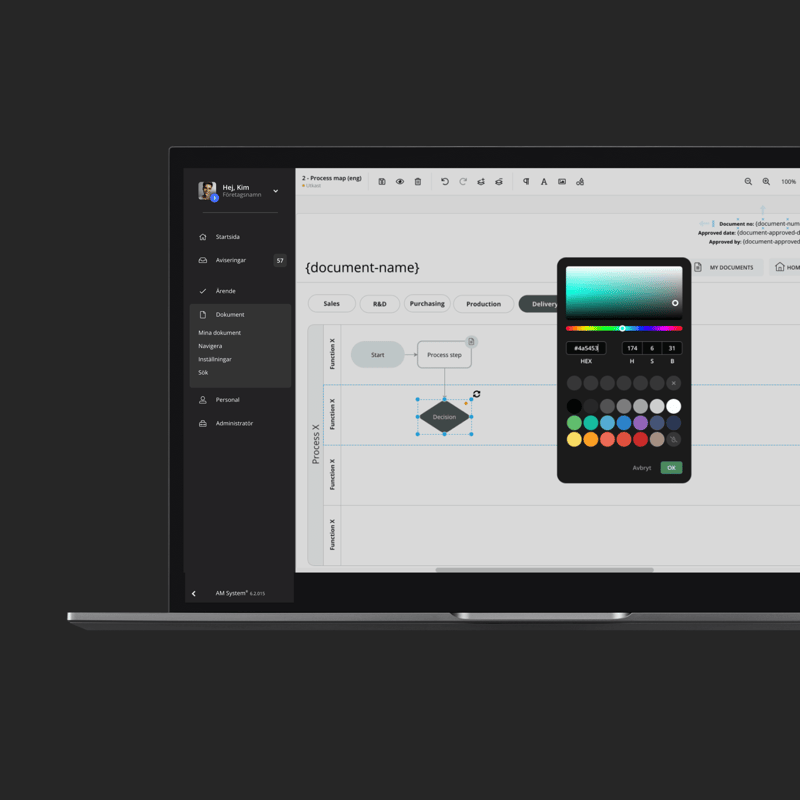Article
10 steps to choose the right quality management system
-
 Editorial team
Editorial team
-
- Quality Management System
- 4 min reading

Choosing the right system support for your management system can be challenging, but with the right approach, the process becomes both easier and more efficient. A well-adapted system will help you structure your work, ensure compliance with standards such as ISO 9001, and improve collaboration within your organization.
"Why do we need another system, we already have paper?"
That's what one of our customers said when the quality manager wanted to introduce a management system. But the person in question stood up and built a system tailored to their needs - a solution that today saves time, creates structure and simplifies their quality work.
But what is the journey from realizing you need a management system to having it implemented? What issues do you need to address to make things run as smoothly as possible?
In this article, we'll walk you through 10 key steps to help you make an informed decision and implement a management system that really makes a difference.
1. Define what the management system will handle
Before choosing a management system, it's important to clarify what processes and areas it will cover. A system that is too comprehensive can be expensive and difficult to manage, while a solution that is too limited can lack important functions. Conducting a needs analysis from the outset will ensure that the system is right-sized and can grow with your business.
- Plan for the future - choose a system that can adapt if your business grows.
- Look into language support if you have international contacts or foreign suppliers.
- Enlist the help of staff with management system experience to set the right requirements.
2. build it yourself or get help?
You can choose to configure the system yourself or hire a consultant. Both options have their advantages and disadvantages, and the choice depends on internal resources and expertise. A user-friendly system should be easy to administer internally, but sometimes external expertise can be crucial for a smooth implementation.
- If you build it yourself - make sure the system is easy to hand over in case of staff changes.
- If you're using help - find out how quickly you can get support and what it costs.
- Make sure you get a solution that can be further developed over time.
3. calculate the costs
A management system is a long-term investment. Make sure you keep track of all cost aspects, both direct and indirect, to avoid unexpected expenses later on. Also consider how the price will be affected if you grow and need more users or increased functionality.
- Examine which features are included and which require additional licenses.
- Find out the cost of installation, updates and training.
- Review how storage space and the number of users affect the price.
4. Choose a reliable provider
Choosing the right supplier is just as important as choosing the right system. A reputable supplier offers good support, security and a future-proof solution. By comparing different providers and asking for references, you can ensure that you get a reliable partner for your management system.
- Ask for references and ask other companies in the industry about their experiences.
- Ensure that the system meets security, availability and storage management requirements.
- Evaluate the supplier's support and customer service - how quickly can you get help?
5. get management on board
Management commitment is crucial to the success of a management system implementation. If decision-makers see the benefits and value of the system, it will be easier to get the whole organization to change and use it fully.
- 1.Present economic benefits, such as time savings and reduced risks.
- Link the system to strategic objectives and business development.
- Identify an internal ambassador to drive implementation.
6.Build employee engagement
To get the whole organization on board with the change, it is important to involve employees early in the process. A user-friendly system and clear communication increase the chances of it being well received and used in daily work.
- Inform about the change early on and ask for input from those who will use the system.
- Use simple and clear language - avoid technical and bureaucratic wording.
- Reduce the workload during the training phase to enable a smooth transition.
7. decide how data will be imported
Whether you currently work with paper, binders or other systems, you need to transfer data to the new management system. A well thought-out data migration plan ensures that important information is not lost.
- Decide whether you will import data yourself or use a supplier.
- Review which documents and records need to be moved and purge unnecessary material.
- Make sure the migration is tested before going live with the new system.
8. plan the implementation
There are different ways to implement a management system - some prefer a phased introduction, while others make a total transition straight away. A well-planned implementation reduces the risk of disruption and creates the conditions for a smooth transition.
- Choose between phased or full implementation - what suits you best?
- If you have multiple systems today - do you want to integrate them or replace them completely?
- Collect feedback on an ongoing basis to adjust and optimize the system as needed.
9. Managing resistance to change
Introducing a management system means a change in working methods, which can be met with resistance. It is therefore important to prepare the organization and create a culture where the system is seen as a natural part of the work.
- Reward the right behavior and create incentives for using the system.
- Make clear the consequences of not using the system.
- Be patient - it takes time to get used to a new way of working.
10. follow up and evaluate
Once the management system is in place, it is important to regularly monitor and evaluate how it is working in practice. By analyzing data and listening to users, you can identify strengths and areas for improvement to ensure that the system continues to meet your needs and requirements.
- Analyze user data and feedback to see how the system is used in your business.
- Conduct regular internal audits and evaluate how well the system supports your processes.
- Adjust and improve continuously - a good management system evolves over time and adapts to new needs and requirements.
Get a demo
Ready to make work easier - and more enjoyable?
Want to see for yourself how AM System can make a difference for you? Book a demo and discover how easy it is to create structure, efficiency, and seamless workflows in your daily operations.
